When you learn how to make jelly at home — this quick grape jelly recipe can be canned or used to make freezer jelly — you’ll save yourself some serious cash, not to mention eliminate some less than ideal ingredients.
Originally published February 2011; this post has been updated
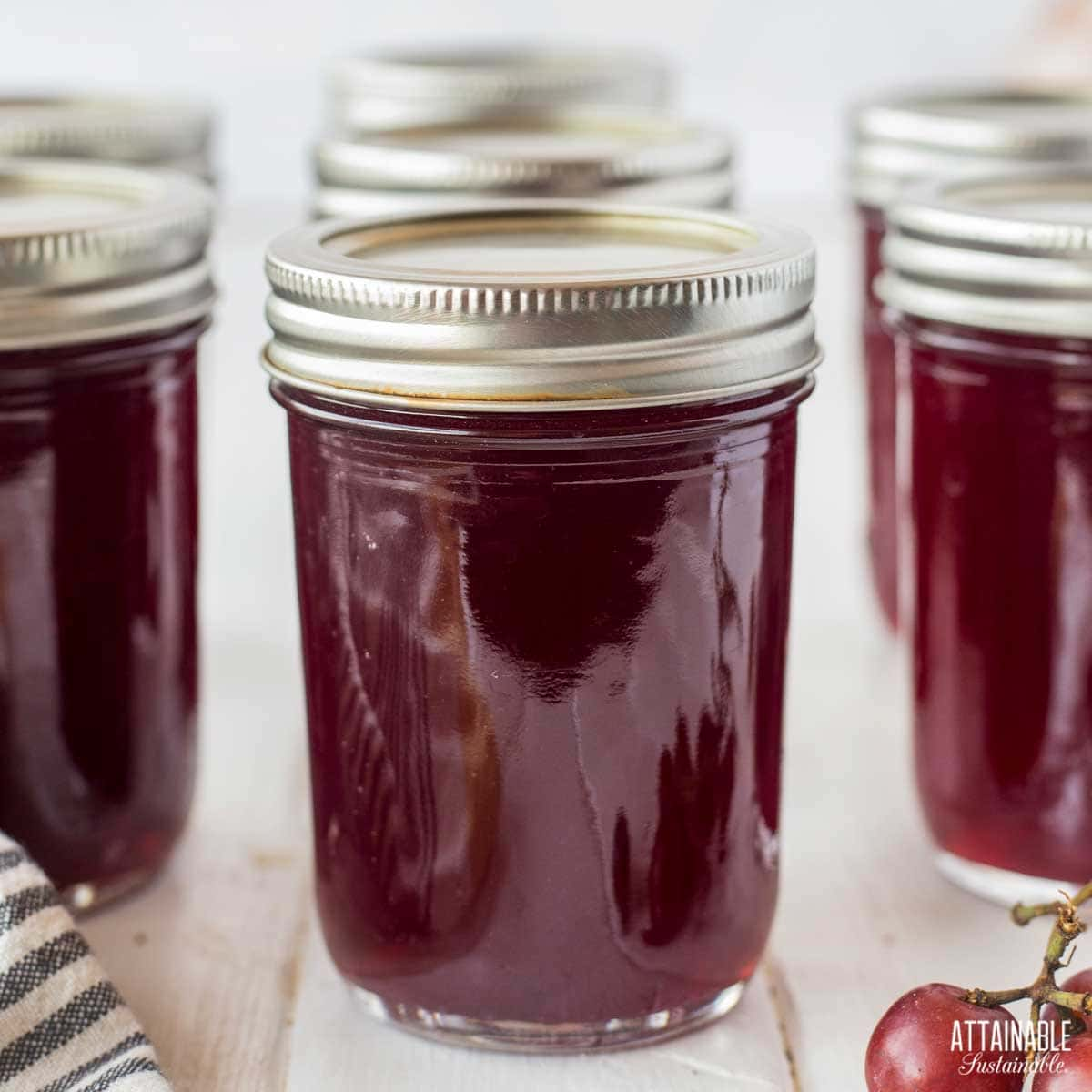
Have you looked at the price of store bought jelly lately? It’s expensive! If you use a lot of jelly (hello, PB&J!), the high cost of jelly can add up.
Plus? You can use better ingredients when you make your own grape jelly. Almost every single brand of jelly that my grocery store carries is made with high fructose corn syrup (HFCS).
I don’t like that. One local brand does use sugar instead of HFCS and there are organic options, but there again, it’s expensive! More than five bucks for slightly more than a cup of jam? This is why I’ve been making my own jam and jelly for years.
5 Easy Steps to Transform Your Pantry!
Ready to switch from store bought to homemade? Let me help you make some changes! Grab my FREE five-part guide to getting started.
Quick Grape Jelly Recipe
This homemade grape jelly recipe works with freshly-juiced grapes or, for a midwinter jelly emergency, let me let you in on a little secret. You don’t HAVE to have fresh grapes on hand.
The Handcrafted Pantry

Ready to DIY your pantry with more wholesome ingredients? Check out my ebook, The Handcrafted Pantry! Filled with delicious recipes for some of your favorite condiments, snacks, and toppings, it’s the guide you need to start skipping packaged products and embrace homemade.
Ingredients
Grape juice – Use freshly juiced grapes (see below for how to do it) or for a quicker jelly, you can use bottled 100% grape juice. The freezer or juice aisle of your grocery store is your ticket to HFCS-free jelly no matter what’s in season. Look for ready-to-serve 100% juice in the drink aisle (you may have to seek out a natural food store) or a frozen concentrate (Welch’s is one brand that offers 100% juice).
Sweetener – I used sugar for this recipe, but you can opt to use honey as well. When I use sugar, The quantities differ a bit, so be sure to check the notes in the recipe card below.
Acidifier – You can use lemon or lime juice in this recipe. The addition of an acidic ingredient like this assures that the pH level is safe for canning. USDA preserving recipes all call for using bottled juice. This assures that the acidity level in recipes is safe for canning.
If you really want to use fresh lemon juice (I get it!) you’ll need to pull out your pH paper to test the acidity of those lemons. In order to properly acidify canned goods, the pH of the lemon juice should be at least 4.5. Do not use Meyer lemons, a cross between a lemon and an orange, for this, as their acidity is too low.
There’s a great discussion about using bottled vs. fresh lemon juice for canning here.
Pectin – This recipe is made using Pomona’s Universal Pectin. This is the only pectin I use anymore as it allows me to use much less sweetener. The standard pectin brands use an obscene amount of sugar in my opinion, often requiring equal amounts of sugar and fruit! This product uses a low methoxyl method and calls for using two different ingredients, which are included in the box: pectin (the large packet) and calcium powder (the small packet). The dry pectin is mixed with the sweetener before being added to the fruit. The calcium water is added directly to the fruit.
What Kind of Grapes are Best?
I have a particular fondness jelly made from Concord grapes, but this recipe works with whatever kind of grapes (or grape juice) you have available to you. You can use purple or white grape juice — it will all taste great! If you’re growing grapes at home, use those! You can even use wild grapes if you’re fortunate enough to find some while foraging.
How to Make Grape Juice
The first step to making homemade grape jam is juicing the grapes. You will need approximately 3-1/2 pounds or 5 to 7-1/2 cups of grapes.If you’re starting with fresh grapes, start by cleaning them. Grapes fresh off the vine tend to be dusty. The easiest way to do this is to fill your sink with water and put the grapes in for a soak.
- Use your hands to carefully remove the grapes from the stems, swishing them around in water as you do.
- Discard any dried up grapes or those that are not yet ripe.
- Place washed grapes in a large stockpot.
- Use a potato masher to crush the grapes, then heat the grapes over medium heat until the juice begins to simmer. Simmer for 10 to 15 minutes, stirring and mashing the grapes every 5 minutes. Remove from heat.
- Place a large, fine-mesh sieve or strainer so that it’s suspended over a large bowl or second stockpot. You could also line a regular colander with a couple layers of cheesecloth. Alternatively, spoon the pulp into a jelly bag and suspend the bag over a bowl to catch the strained juice. You will need 4 cups of juice.
- Spoon the cooked grapes and their juice into the sieve. Cover loosely with a cloth and refrigerate for several hours or overnight. As the grapes sit, the juice will drain through the sieve into the bowl, leaving behind the grape pulp. If you’re using seedless grapes, that pulp can be added to smoothies! Otherwise, compost it.
How to Make Jelly with Less Sugar
I’ve been using Pomona brand pectin (available at health food stores) exclusively because it allows me to use less sugar. Learning how to make grape jelly (or other jams and jellies) with Pomona pectin means you can ditch the guilt about serving over-sweetened spreads to your family. You really don’t have to use multiple cups of sugar for a good jelly recipe.
Using Pomona brand pectin requires mixing a batch of calcium water. There will be more than you need for this grape jelly recipe; just keep the excess in your refrigerator for the next time you make jelly. Because c’mon – now that you know how to make grape jelly, you’ll want to try your hand at making Lilikoi (Passion Fruit) Jelly, right?
Canning Jelly
You’ll need special canning jars, lids, and rings (read more about canning equipment here) to make this orange jelly recipe shelf-stable, but the process isn’t difficult.
Use quarter-pint or half pint jars for this recipe.
Transfer the hot jelly mixture to hot jars made for canning, leaving a quarter-inch headspace. Wipe rims of jars. Wipe rims of jars. Set the flat lid in place and screw on the band.
Once the jars are filled, you’ll process them in a boiling water canner. What this means is you’ll put the filled and sealed jars of jelly into boiling water and heat them for ten minutes. This assures that the jars will seal well.
You might be able to use a large pot, rather than a special water bath canner.
Here’s a more detailed look at canning jam and jelly.
🍅 Safety First!
Canning is an excellent way to preserve food for the pantry, but there are some important safety considerations to keep in mind. The recipes on this site have been made following safe canning procedures by a certified Master Food Preserver.
- Know the difference between water bath canning and pressure canning. Low acid items must be pressure canned for safety.
- Altering ingredients may change the recipe’s pH, posing a safety issue.
- Use the proper jars and lids. Never reuse lids, with the exception of the Tattler or Harvest Right hard plastic lids that are intended for such a purpose.
- For more on canning equipment, please go here.
- Want to learn more? The National Center for Home Food Preservation is the go-to resource for safe canning information.
How to Freeze Grape Jelly
Use straight-sided canning jars for freezer jelly and only fill the jars 3/4 full. This prevents breakage. For more information about freezing in canning jars, go here.
Homemade Grape Jelly is Easy!
Making jam or jelly is so easy. It took me less than an hour to make three pints of jelly for around $10. If you’re new to this, it might take you an HOUR.
Spread this grape jelly on peanut butter sandwiches, on homemade English muffins (leave out the herbs!) or this family favorite sweet cornbread recipe. Or for a fun summertime drink, use it in a glass of jam seltzer!
Storage
Processed properly in a hot water bath canner, this homemade jelly can be stored at room temperature in the pantry. Use it within 12 to 18 months for best quality, though as long as the seal remains intact, the contents are safe to consume.
Have plenty of grapes? Try canning whole grapes for the pantry, too! Ready to add more fruit spreads to your pantry? Try this homemade strawberry jam or this raspberry jam with apricots and honey!
★ Did you make this quick grape jelly recipe? Don’t forget to give it a star rating below!
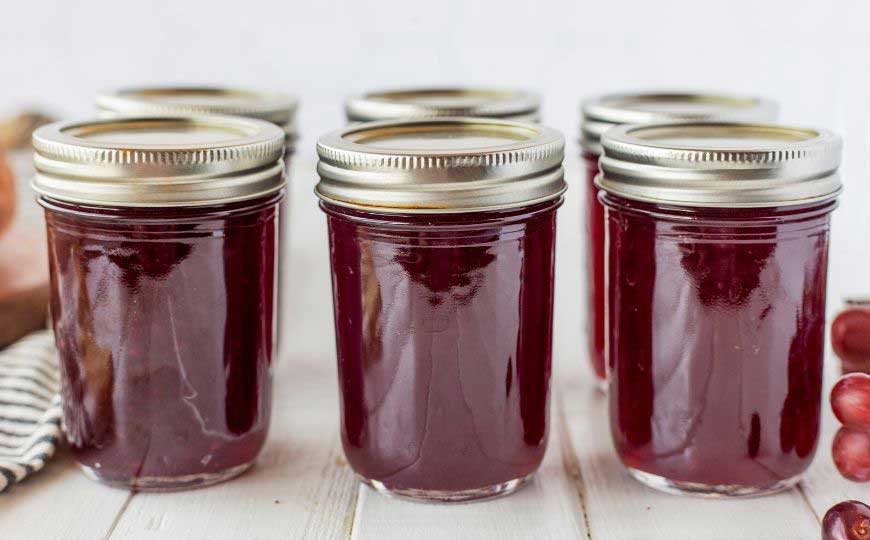
How to Make Grape Jelly
Ingredients
- 4 cups grape juice (if you're using frozen concentrate, reconstitute before measuring)
- ¼ cup lemon or lime juice
- ¾ - 2 cups granulated organic cane sugar or 1/2 - 1 cup honey
- 4 teaspoons calcium water from Pomona's pectin box
- 4 teaspoons pectin from Pomona's pectin box
Instructions
PREPARE FOR CANNING
- Prepare the calcium water:Combine ½ teaspoon calcium powder (from the small packet in the box of Pomona’s pectin) with ½ cup water in a small jar. Screw on a lit and shake until well-combined. You'll have more than you need for this recipe. Store the excess in the refrigerator for use in making additional jam or jelly recipes.
- Wash the jars you'll use, making sure each is clean and free of nicks in the rim, which could impede sealing.
- Wash the lids and rings in hot soapy water. (If you're using non-Ball brand lids, prepare as suggested by manufacturer.)
- Place empty jars in a canning pot or large stock pot with enough water to cover by an inch or two, cover pot, and set on high heat. It can take awhile for the water to heat, so get it started before you begin making the recipe.
MAKE THE GRAPE JELLY
- Measure the grape juice, lemon juice, and 4 teaspoons of prepared calcium water into a large saucepan; bring to a full rolling boil. (Save the remaining calcium water in the fridge for a future batch of jelly.)4 cups grape juice, 1/4 cup lemon or lime juice, 4 teaspoons calcium water
- Meanwhile, combine the sweetener with the pectin until it's thoroughly combined.3/4 - 2 cups granulated organic cane sugar, 4 teaspoons pectin
- When the grape mixture comes to a boil, stir in the pectin and sweetener, stirring vigorously for 1 to 2 minutes to dissolve the pectin while bringing the jelly back to a boil. You can use your immersion blender to do this, if you have one. Otherwise, whisk vigorously.
- Remove from heat when the jelly boils.
- CANNING THE JAM
- Ladle hot jam into quarter-pint, half-pint, or pint sized jars, leaving 1/4" head space. A canning funnel makes this easy.
- Wipe jar rims to remove any jam that may have spilled. A clean rim is essential to a good seal.
- Set jar lids in place. Screw bands on finger tight.
- Use a jar lifter to gently place jars into hot water in a canning pot equipped with a rack. Water should cover the top of the jars by an inch. The water will cool somewhat in reaction to the addition of the jars. Return the water to a simmer and then set the timer.
- Process for 10 minutes 0-1,000 feet altitude; add an additional minute for every additional 1,000 feet in elevation.
- Remove jars from water using the jar lifter and transfer to a solid, towel-covered surface. Allow to cool for 24 hours.
- Check seals. Lids should be solid and pulled down tight. (if they flex and pop, the jar didn’t seal; put unsealed jars in the refrigerator and use those first).
- Remove rings and wash outsides of jars. Store in a cool, dry place.
FOR REFRIGERATOR OR FREEZER JELLY
- If you'll use the jelly within a month or so, you can just refrigerate it. In this case, you can fill the jars to within 1/4" of the top.
- To freeze, use straight-sided jars and only fill them 3/4 full to allow room for expansion when frozen.
- Screw on lid and allow to cool before placing jelly in the refrigerator or freezer.
Notes
- This recipe is made using Pomona’s Universal Pectin. This is the only pectin I use anymore as it allows me to use much less sweetener. The standard pectin brands use an obscene amount of sugar in my opinion, often requiring equal amounts of sugar and fruit! This product uses a low methoxyl method and calls for using two different ingredients, which are included in the box: pectin (the large packet) and calcium powder (the small packet).
- Boiling lids or heating above 180°F as once recommended can damage the sealing compound.
- SOURCE: Adapted from Pomona's Universal Pectin.

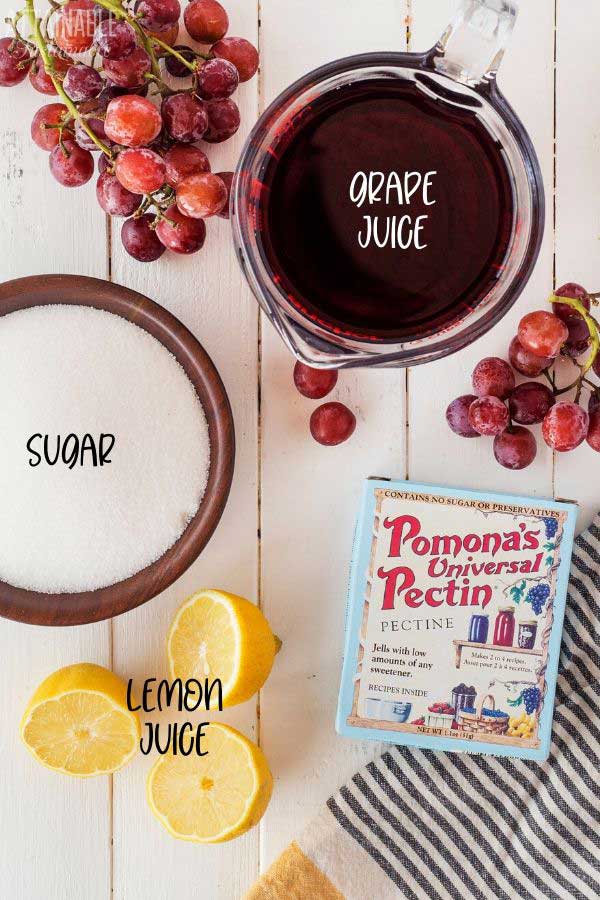
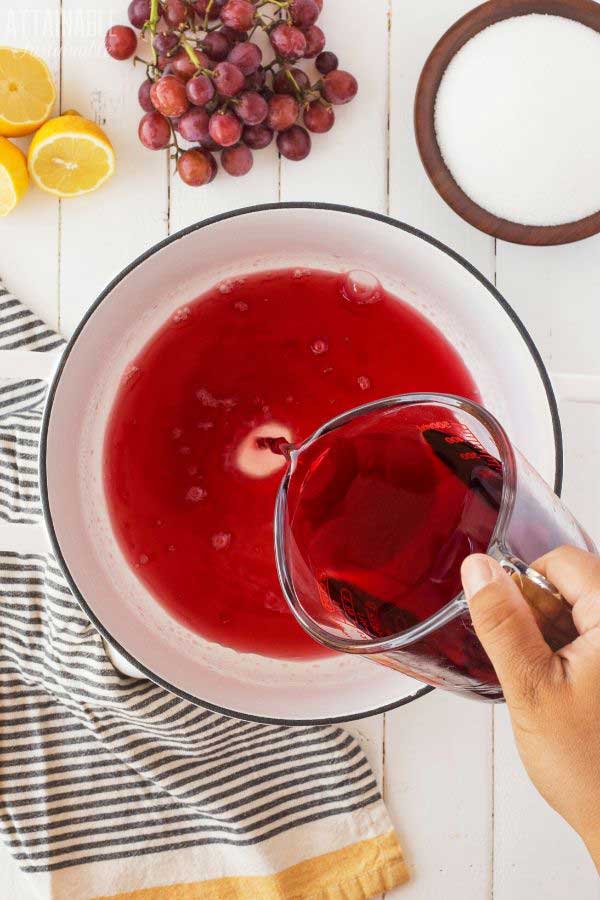
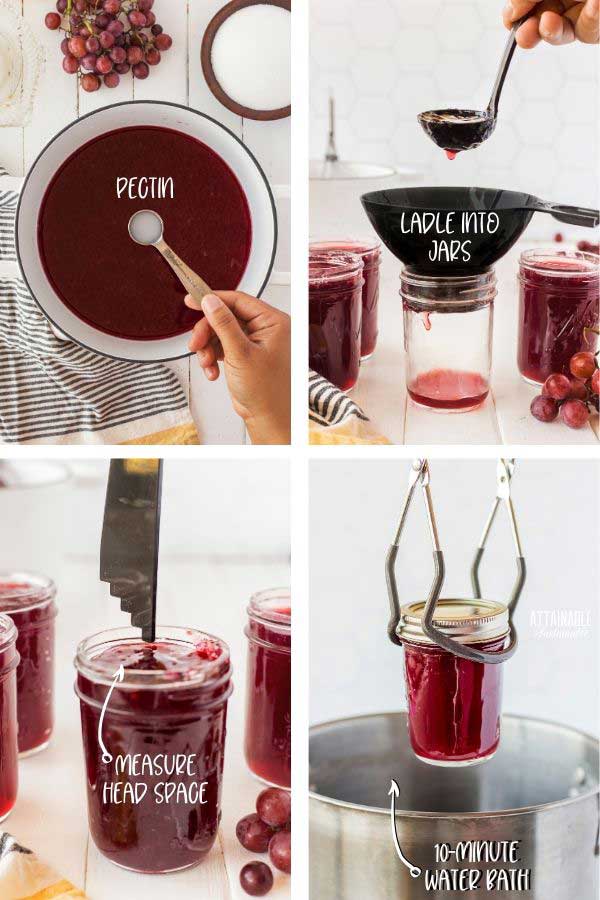
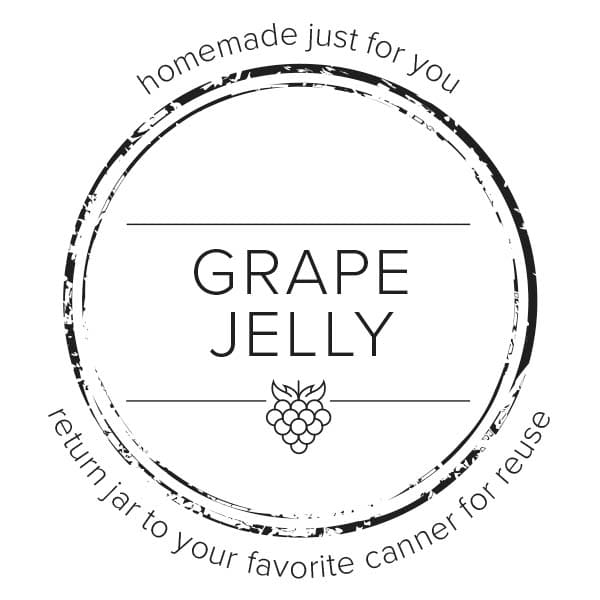
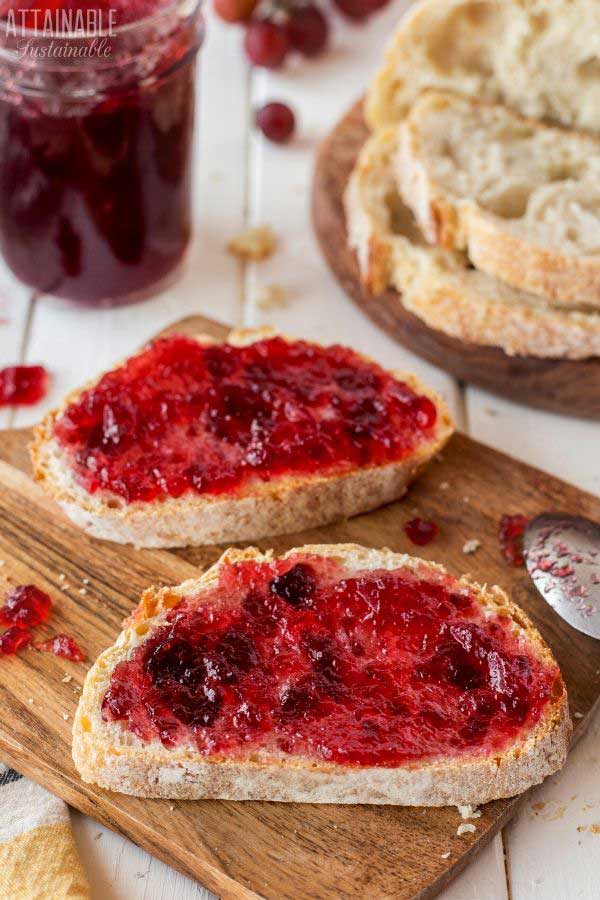
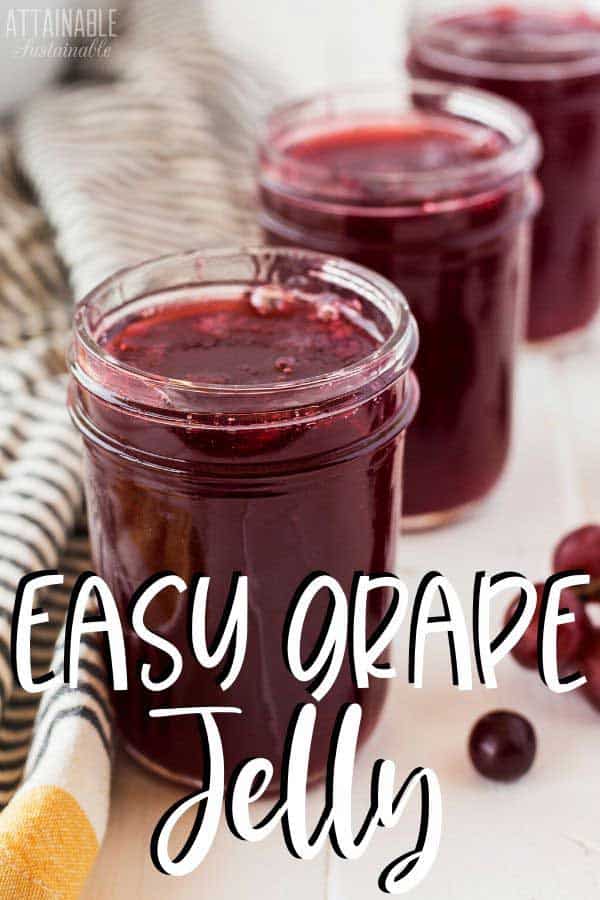





Question. I never heard of your type of pectin, I’ve always used sure jell with all the jams I’ve made, I am trying jelly this time. Why can’t I use the sure jel?
l
You can use Sure Jel! But this recipe is written to be low sugar and uses Pomona Pectin. To use Sure Jel, follow the instructions in the box.
Do I use just regular grape juice like the stuff in plastic container at the grocery store (think Welch’s) ? Doesn’t that already have sugar in it? I am confused what kind of juice to buy. Sorry if this is a dumb question 🙁
Look for ready-to-serve 100% juice in the drink aisle (you may have to seek out a natural food store) or a frozen concentrate (Welch’s is one brand that offers 100% juice). Not a dumb question at all! 🙂
If I don’t have the pemona pectin, what would be my measurements using regular powdered pectin and sugar?
They’re totally different procedures and not interchangeable.
How long to water bath in pint size jars?
10 minutes.
Could I use the same proportions to make strawberry jelly?
This recipe has only been tested as written; altering canning recipes is not recommended and can result in an unsafe food product. I do have a strawberry jam recipe though: https://www.attainable-sustainable.net/easy-homemade-strawberry-jam-recipe/
I have successfully made jelly from juice. Have anyone made jelly from nectar or
thicker juices. I am thinking mango or guava. I will be trying it out over the weekend but wonder if someone had experience with that.
As long as it’s 100% nectar/juice, it should be fine. When I make my mango jam from fresh fruit the starting liquid is much like the bottled nectar, somewhat thick and pulpy. Technically, I think this would be considered a jam rather than a jelly, but same idea!
Mango jam recipe: https://www.attainable-sustainable.net/mango-jam/
Can I freeze the grape jelly after it is in glass jars?
Yes, just be sure you leave enough headspace and use straight-sided jars. https://www.attainable-sustainable.net/freezing-mason-jars/
If I only made enough for one jar do I have to boil for canning or can I just keep in the fridge since it will be used right away??
Oh, you can just refrigerate! Canning is just to make it shelf stable for longer storage.
How best to freeze figs?
What is the calcium powder mix for ? I make a lot of jams syrups usually cause I can’t get them to thicken or set up with less sugar so I make into a syrup. Does the Calcium powder help with setting? Never tried that brand of pectin silly use the Walmart pectin the only one they have but the one for less sugar?
The calcium powder is specific to the Pomona brand of pectin.
If using Concord grapes, how much do you use?
This might help? https://food.unl.edu/documents/Canning%20Grapes%20and%20grape%20juice.pdf
So easy to make and super tasty!
This would be a really fun activity to do with the kids on a snow day. Thank you! Pinned!
Great! I want to make home made jelly but I have no idea how to make one.
At which point do you add the lemon juice?
Step 1 – edited to clarify!
@Attainable Sustainable
Thanks! This was so quick, easy, and turned out great.
Oh, yay! Love to hear that!
I’m wanting to substitute stevia for the sugar, would that work. Does the amount of sugar matter for setting or just for taste? Because only a few stevia packets would be necessary for the same amount of sweetness. Also i wonder if agave would work as a substitute. I use it in place of honey a lot because it’s cheaper.
Tara, this is why I like Pomona pectin – it allows for using a variety of sweeteners. The sugar is not necessary for the jam/jelly to set. I’ve not personally tried it with stevia, but the Pomona instructions include several alternatives.
Great stuff. No need to make a thousand jars of jam or jelly. You CAN make a few even in the dead of winter. Love it.
I made 3 double batches, and they aren’t setting up! What did I do wrong? I followed the recipe precisely other than doubling it. Can I dump them back into the pot and boil them longer to set it up?
Sorry; I just saw this. It will set up as it cools. But if it didn’t, I’m not sure what happened! Use it as pancake syrup??
Jelly is still running. Should I dump them back in pot to reheat and add pectin to it
Jelly takes a bit to set up. It’s pourable when it goes in the jars.
What a great idea. I never thought of making jelly from juice!
It is so easy and accessible to make jelly with juice!